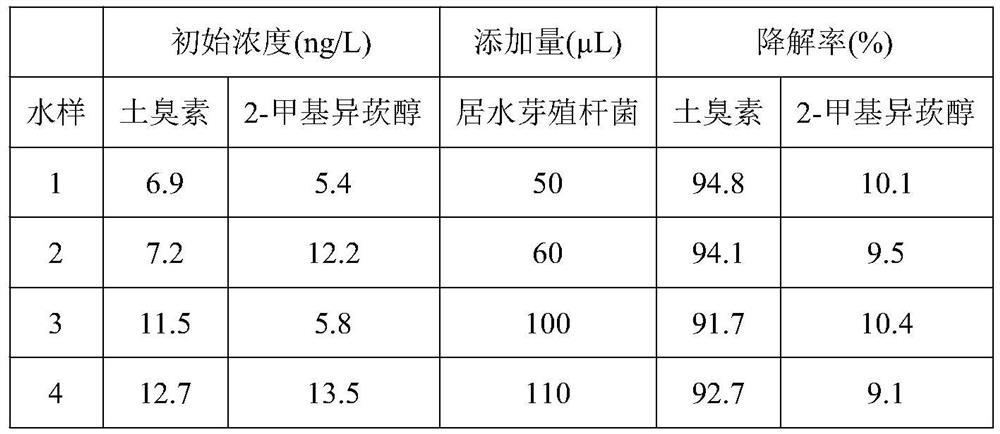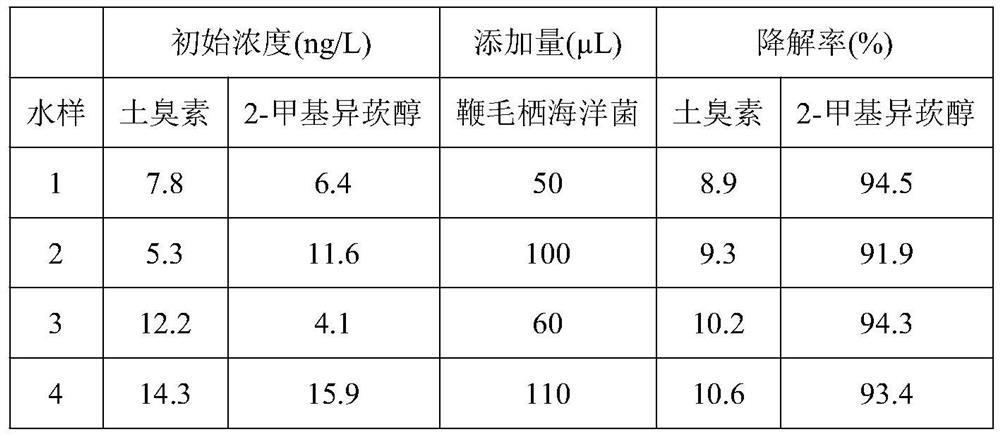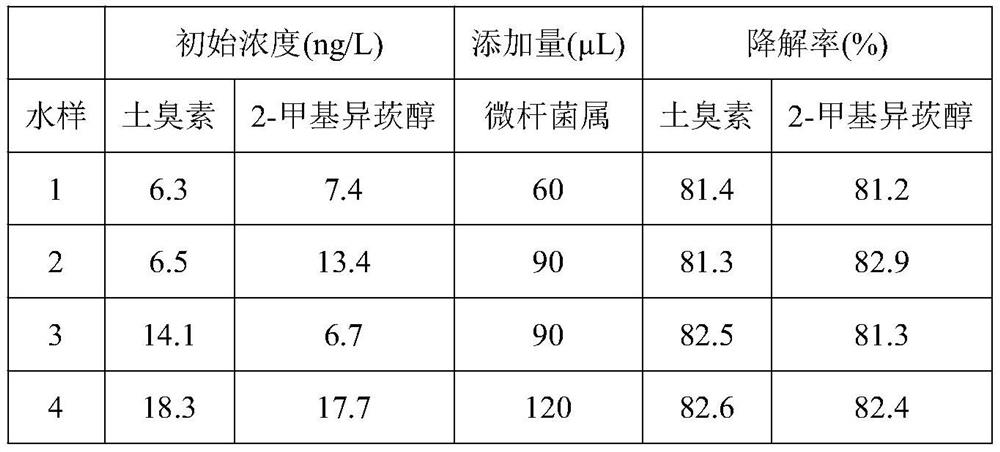Application of microecological preparation in removing earthy smell and method for removing earthy smell of fishes in RAS system
An earthy smell and fish technology, which is applied in the field of aquatic product aquaculture, can solve the problems of time-consuming, high cost, increase fish diseases, etc., and achieve the effect of removing earthy smell and low energy consumption.
- Summary
- Abstract
- Description
- Claims
- Application Information
AI Technical Summary
Problems solved by technology
Method used
Image
Examples
Embodiment 1
[0038] Get 100L cultured water body in 250L shaking flask, add Bacillus hydrohabitatus bacterium liquid (10 10 cfu / mL), at 120rpm, cultivated 48h under 30 DEG C of conditions, and the degradation rate of Bacillus hydrohabitatus to geosmin and 2-methylisoborneol in the aquaculture water body is shown in Table 1.
[0039] Table 1. Degradation rate of geosmin and 2-methylisoborneol by Bacillus hydrous
[0040]
[0041] As can be seen from Table 1, the degradation rate of geosmin in the aquaculture water body by Bacillus aquaticus is more than 91.7%, and the degradation rate of 2-methylisoborneol is lower than 10.4%, which shows that Bacillus aquaticus has a certain effect on geosmin With good degradation ability, Bacillus hydrohabitatum can be used to degrade geosmin to remove earthy smell.
Embodiment 2
[0043] Get 100L cultured water body in 250L shaking flask, add flagellate marine bacterium bacterium liquid (10 10 cfu / mL), at 120rpm, cultivated 48h under 30 ℃ of conditions, flagellate marine bacterium is as shown in table 2 to the degradation rate of geosmin and 2-methylisoborneol in aquaculture water.
[0044] Table 2 Degradation rates of geosmin and 2-methylisoborneol by flagellar-dwelling marine bacteria
[0045]
[0046] It can be seen from Table 2 that the degradation rate of flagellate marine bacteria to 2-methylisoborneol in aquaculture water is above 91.9%, and the degradation rate of geosmin is below 10.6%, which shows that flagellate marine bacteria have a higher rate of degradation of 2-methylisoborneol. Isoborneol has good degradation ability, and flagellate marine bacteria can be used to degrade 2-methylisoborneol to remove the earthy smell.
Embodiment 3
[0048] Get 100L culture water body in 250L shaking flask, add Microbacterium bacterium liquid (10 9 cfu / mL), cultivated at 120rpm and 30°C for 48h, the degradation rates of microbacteria to geosmin and 2-methylisoborneol in the culture water are shown in Table 3.
[0049] Table 3 The degradation rate of microbacteria to geosmin and 2-methylisoborneol
[0050]
[0051] As can be seen from Table 3, the degradation rate of microbacteria to 2-methylisoborneol in the aquaculture water body is more than 81.2%, and the degradation rate of geosmin is more than 81.3%, which shows that microbacteria are to geosmin and 2-methylisoborneol. Camphenol has good degradation ability, microbacteria can be used to simultaneously degrade geosmin and 2-methylisoborneol to remove earthy smell.
PUM
 Login to View More
Login to View More Abstract
Description
Claims
Application Information
 Login to View More
Login to View More - R&D
- Intellectual Property
- Life Sciences
- Materials
- Tech Scout
- Unparalleled Data Quality
- Higher Quality Content
- 60% Fewer Hallucinations
Browse by: Latest US Patents, China's latest patents, Technical Efficacy Thesaurus, Application Domain, Technology Topic, Popular Technical Reports.
© 2025 PatSnap. All rights reserved.Legal|Privacy policy|Modern Slavery Act Transparency Statement|Sitemap|About US| Contact US: help@patsnap.com



